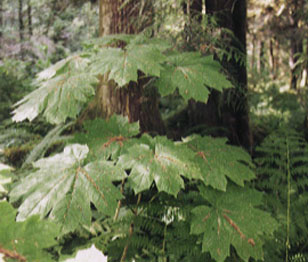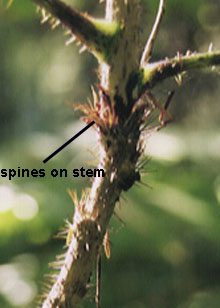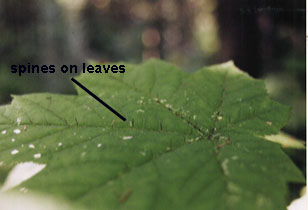


General Species Description
- Devil's club is an erect to sprawling, deciduous shrub that is usually 1-3 m tall. It is easily recognized by its sharp, needle-like spines covering its stems and leaves. The spines are anywhere from 5 to 10 mm long. The stem is a light tan to yellow color and crooked, almost unbranched. The wood has a sweet, musky aroma.
Leaves
- The leaves of Devil's club are alternate and deeply palmate with 7-9 sharply pointed lobes. They have unevenly toothed margins, are bright green and 10-35 cm across. The veins of the leaves are covered with sharp spines.
Inflorescence/Flowers
- The flowers grow in a pyramidal terminal cluster made up of numerous compact flower heads. The flowers are small and whitish-green in color. They have five petals and are 5-6 mm long.
Fruits
- The fruits are bright red, flattened berries that are arranged in a large terminal pyramidal cluster. They are shiny with 2-3 seeds and are 4 mm long. The seeds are inedible to humans but are a favorite to bears.
Habitat
- Devil's club is commonly found in moist wooded areas, especially those that are well-drained seepage areas or along stream corridors. It has also been found in avalanche tracks and roadside ditches. It has been found in low to middle elevations, however it sometimes grows in subalpine forests and to the timberline in the north. It prefers shaded areas with nitrogen-rich soils. Common plant associates of Devil's club are lady fern (Athyrium filix-femina), bedstraws (Gallium species), skunk cabbage (Lysichiton americanum), and three- leaf foamflower (Tiarella trifoliata).
Range
- Devil's club can be found on both sides of the Cascade Mtns. in northern Oregon and throughout Washington, British Columbia and Alaska. It sometimes forms thickets that are impenetrable along the coasts of the northern Pacific. It can also be found in Alberta, Canada and as far east as Michigan.
Similar Species
- While Devil's club is fairly unique in that it is covered with sharp spines, it can still be confused with other plants. Thimbleberry (Rubus parviflorus) has large palmate leaves but lacks the spines on both its leaves and stems. Swamp gooseberry (Ribes lacustre) is smaller than Devil's club with much finer spines. The leaves of gooseberry are also much smaller than those of Devil's club. Also, gooseberry is not aromatic.
Ecological Value
- Devil's club leaves are eaten by slugs and the fruits are eaten by bears. It works as an effective buffer against humans and/or livestock to prevent the intrusion into wetland areas.
Human Value
- Devil's club is a very important plant to the native people throughout its range, and is still the most important medicinal plant to those of the B.C. coast. Ailments such as arthritis, ulcers, digestive tract problems, and diabetes were treated with Devil's club. It was used as a cleansing purgative and as an infusion for colds. It was also used with other plants to fight against tuberculosis and to establish regular menstruation after childbirth. It was used to reduce fever and swollen glands. Devil's club was also thought to have very spiritual powers. Sticks from it were thought to ward off evil spirits. Charcoal from burnt Devil's club was used as protective face paint for native dancers. A dye was also made from charcoal that was used to dye baskets or use in tatooing. Pulverized bark was used as a deoderant, perfume or baby talc. Devil's club berries were rubbed on the scalp to combat lice and dandruff. The spines of Devil's club stems were used as fishing lures. Every part of the Devil's club plant was used by navtive peoples of the region and today it is still being used in many of the same ways.
References
- Cooke, Sarah Spear, 1997. A Field Guide to the Common Wetland Plants of Western Washington & Northwestern Oregon. Seattle Audubon Society and Washington Native Plant Society. Seattle Audubon Society. Seattle WA, 417pp. Matthews, Daniel, 1988. Cascade-Olympic Natural History. Moore, Michael, 1993. Medicinal Plants of the Pacific West. Pojar, Jim & Mackinnon, Andy, 1994. Plant of the Pacific Northwest Coast; Washington, Oregon, British Columbia and Alaska. B.C. Ministry of Forests and Lone Pine Publishing. Lone Pine Publishing. Canada, 527pp. Turner, Nancy J. ed. 1995. Food Plants of Coastal First Peoples.
This page was created by: Mandy Summer, August 1998
Return to Northwestern Oregon Wetland Plants Project